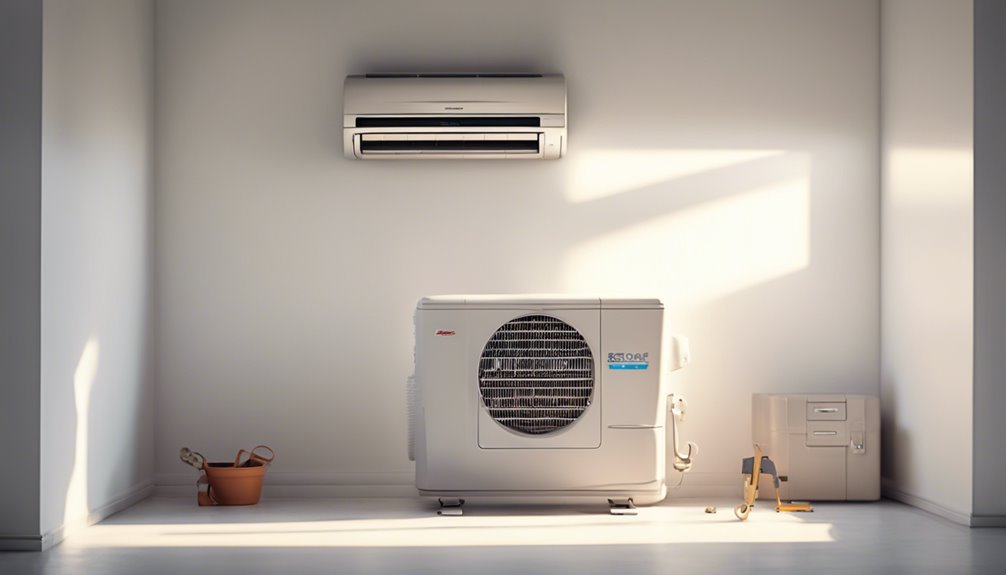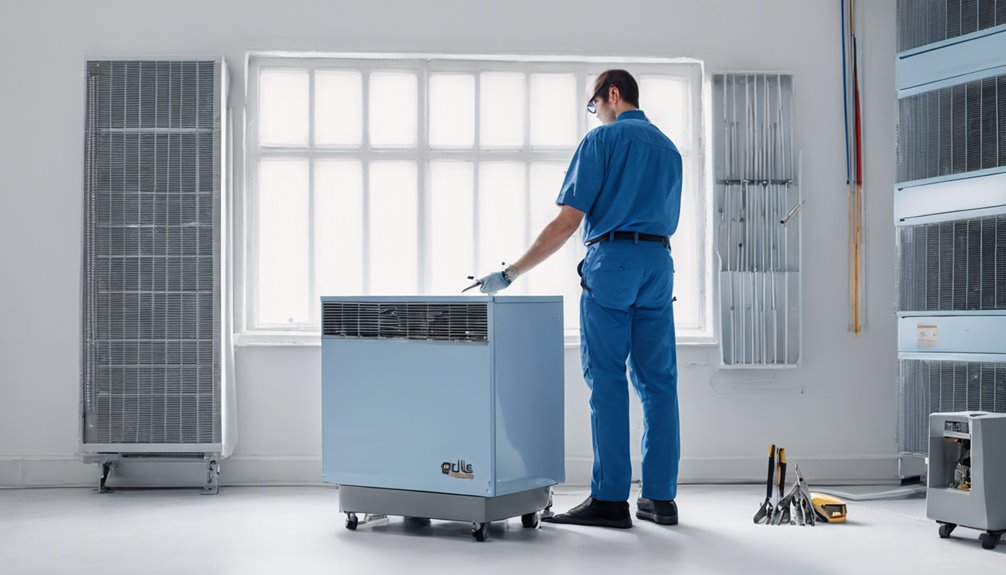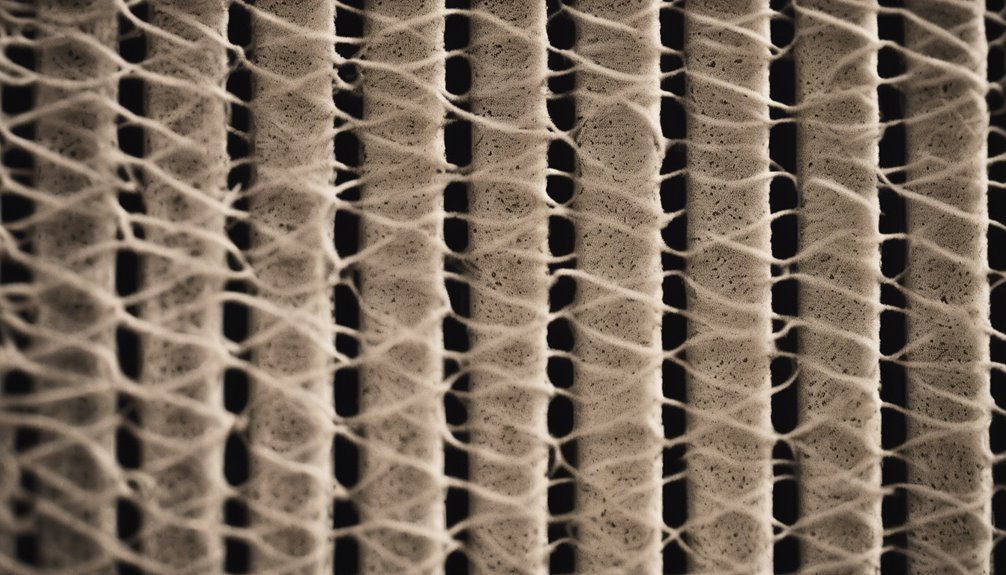If your AC is running but not cooling your room, it's likely due to one of several common issues. You might have a system imbalance, airflow restrictions, thermostat problems, refrigerant leaks, or compressor and condenser coil malfunctions. Check your air ducts and vents for blockages, dirty filters, and leaks. Ensure your thermostat is set correctly and functioning properly. If you're still stumped, there may be underlying electrical or refrigerant issues at play. Keep investigating to uncover the root cause and get your AC running smoothly again.
Key Takeaways
- Check for system imbalance and installation issues, as a mismatched AC size or damaged insulation can reduce cooling performance.
- Ensure proper airflow and ventilation by inspecting for dirty or clogged vents, leaks, and disconnections in air ducts and vents.
- Verify thermostat settings and inspect for electrical issues, such as faulty wiring or tripped circuit breakers, that may prevent cooling.
- Look for refrigerant leaks, dirty condenser coils, or compressor overload, which can cause the AC to run continuously without cooling.
- Perform regular maintenance and inspection of air ducts, vents, and condenser coils to prevent blockages and ensure unobstructed airflow.
Common Causes of Inadequate Cooling
When your air conditioner is running but not cooling, it's frustrating and uncomfortable.
You expect a cool oasis in your home, but instead, you're stuck with a warm, sticky environment.
One common cause of inadequate cooling is mismatched cooling expectations.
If your AC isn't sized correctly for your space, it'll struggle to cool your room effectively.
Another issue is system imbalance, where the AC's components aren't working in harmony.
This can lead to reduced airflow, increased energy bills, and a whole lot of disappointment.
Inspecting the Air Ducts and Vents
You'll want to inspect your air ducts and vents to identify potential issues that might be hindering your AC's cooling performance.
Check for dirty or clogged vents, which can restrict airflow, and look for leaks or disconnections that can let cool air escape.
Additionally, inspect the ducts' insulation and condition for damage that could be compromising your AC's ability to cool effectively.
Dirty or Clogged Vents
Air ducts and vents are the unsung heroes of your AC system, quietly working behind the scenes to circulate cool air throughout your home.
However, when vents become dirty or clogged, it can significantly hinder ventilation importance and airflow optimization. You mightn't even notice it's happening until your room isn't cooling properly.
Check your vents for these common issues:
- Dust and dirt buildup: A thick layer of dust and dirt can block airflow, reducing the effectiveness of your AC.
- Debris accumulation: Leaves, twigs, or other outdoor debris can clog vents, preventing cool air from circulating.
- Pet hair and dander: If you have pets, their hair and dander can accumulate in vents, restricting airflow.
Leaks and Disconnections
Leaks in your air ducts and vents can silently sabotage your AC's performance, causing the cool air you crave to escape. Air leaks and duct disconnections can be a major culprit behind your AC's inefficiency. When inspecting your air ducts and vents, look for signs of damage, rust, or corrosion. Check for loose connections, gaps, or holes that can let cool air escape.
| Area to Inspect | What to Look For | Action to Take |
|---|---|---|
| Duct joints | Loose connections, gaps, or holes | Seal or replace duct joints |
| Vent covers | Rust, corrosion, or damage | Replace vent covers |
| Ductwork | Kinks, bends, or sagging | Straighten or replace ductwork |
Insulation and Damage
As you inspect your air ducts and vents, don't overlook the role of insulation and damage in reducing your AC's cooling performance.
Poor insulation can lead to heat retention, making your AC work harder to cool your room.
Check for signs of damage, such as:
- Tears or holes in the ductwork, which can let hot air in and cool air out.
- Loose or missing insulation, which can reduce the ducts' ability to retain cool air.
- Corroded or rusted vents, which can restrict airflow and reduce cooling performance.
Thermostat Troubleshooting Tips
When your thermostat seems to be malfunctioning, it's essential to identify the root cause of the problem.
You'll want to check if it's correctly set to "cool" mode and if the temperature is set low enough to trigger the AC. If you have a smart thermostat, use its app to check the thermostat's status and settings.
Ensure the thermostat app is updated and synced with your device. Also, check for any error codes or alerts that might indicate the issue.
If you're still unsure, try resetting the thermostat or replacing its batteries. By following these steps, you'll be able to troubleshoot and potentially resolve the issue with your thermostat.
The Role of Refrigerant in Cooling
Your air conditioner's cooling capabilities rely heavily on refrigerant, a crucial component that facilitates heat transfer from your home's interior to the outside environment.
Refrigerant is responsible for absorbing heat from the air and transferring it outside, making your home cooler. There are different types of refrigerant, including chlorofluorocarbons (CFCs), hydrochlorofluorocarbons (HCFCs), and hydrofluorocarbons (HFCs), each with unique properties.
- Low boiling point: Refrigerant must evaporate quickly to absorb heat efficiently.
- High latent heat of vaporization: Refrigerant should be able to absorb and release a lot of heat energy.
- Low pressure and temperature: Refrigerant must be able to operate within a wide range of pressures and temperatures.
Compressor and Condenser Coil Issues
If your AC is running but not cooling, you might want to check the compressor and condenser coil.
If the compressor isn't turning on, it's likely the culprit behind your AC's cooling issue.
You should also inspect the condenser coil for dirt and grime, and check for refrigerant leaks that could be affecting the system's performance.
Compressor Not Turning On
The compressor is the heart of your air conditioning system, responsible for compressing refrigerant and pumping it through the coils to facilitate heat transfer.
If it's not turning on, your AC won't cool your room. You need to identify the reason behind this issue.
- Power supply issues: Ensure that your AC is receiving a steady power supply. Check your circuit breaker or fuse box to see if a tripped breaker or blown fuse is preventing the compressor from running.
- Electrical connection problems: Verify that all electrical connections to the compressor are secure and not loose. A faulty connection can prevent the compressor from receiving the power it needs to operate.
- Compressor overload: If your compressor has overloaded, it may have tripped its internal safety switch, preventing it from turning on. Check your AC's manual to see how to reset the compressor.
Dirty Condenser Coil Issues
A dirty condenser coil can silently sabotage your air conditioning system, causing the compressor to work harder and ultimately leading to its failure.
You mightn't even notice it's happening until your energy bills skyrocket or the compressor breaks down. But it's not too late to take action.
Regular condenser cleaning is key to keeping your AC running smoothly. Make coil maintenance a priority by checking and cleaning the condenser coil every few months.
Use a garden hose to gently remove dirt and debris, and consider using a specialized coil cleaning solution for tougher grime. By staying on top of condenser cleaning, you can prevent unnecessary wear and tear on your AC system and keep your room cool and comfortable.
Refrigerant Leaks Detected
You've addressed the dirty condenser coil, but now it's time to tackle another common issue: refrigerant leaks.
Refrigerant loss can cause your AC to run continuously without cooling the room. Leak detection is crucial to identify the source of the problem.
Here are common signs of refrigerant leaks:
- Ice buildup: Ice forms on the evaporator coils or copper lines, indicating refrigerant is escaping.
- Hissing sounds: You hear hissing or gurgling noises coming from the AC unit, indicating refrigerant is leaking out.
- Increased electricity bills: Your electricity bills are higher than usual, as the AC works harder to cool the room.
If you suspect a refrigerant leak, it's essential to contact a professional to inspect and repair the AC unit.
Blockages and Restrictions in Airflow
Airflow restrictions can silently sabotage your AC's cooling performance, leaving you sweating and frustrated.
You mightn't even realize it, but airflow obstacles can be hiding in plain sight. Check your air vents for blockages like furniture, curtains, or clutter. Make sure they're at least three feet away from any obstructions.
Ventilation barriers like closed or blocked registers can also hinder airflow. Open them up to let the cool air flow freely.
Don't forget to inspect your air filter – a dirty or clogged filter can significantly reduce airflow. Clean or replace it as needed.
Electrical and Capacitor Problems
Now that you've cleared the way for unobstructed airflow, it's time to shift your attention to the electrical system.
Electrical and capacitor problems can be the culprit behind your AC's inability to cool the room.
Faulty wiring can cause the AC to malfunction, while electrical surges can damage the capacitor, leading to a breakdown in the cooling system.
Here are some common electrical and capacitor issues to look out for:
- Tripped circuit breakers: If your AC keeps tripping the circuit breaker, it may be a sign of electrical issues.
- Burnt or corroded wires: Check for signs of wear and tear on the wires, as faulty wiring can prevent the AC from functioning properly.
- Capacitor failure: A faulty capacitor can prevent the compressor and fan motor from working, resulting in a lack of cooling.
Frequently Asked Questions
Can I Use a Dehumidifier to Help My AC Cool Better?
You're wondering if a dehumidifier can help your AC cool better. Yes, it can! By reducing humidity levels, you'll lower energy consumption and enable your AC to cool more efficiently, making your space feel cooler and more comfortable.
Why Does My AC Make My Room Feel Humid?
You notice your AC makes your room feel humid because it's not effectively removing moisture. When humidity levels rise, moisture buildup occurs, and your AC can't keep up, leaving your room feeling sticky and uncomfortable.
Can I Clean My Ac's Condenser Coils Myself?
You can clean your AC's condenser coils yourself, saving money on professional maintenance. Simply turn off the power, remove debris, and gently hose down the coils to ensure efficient cooling and prolong their lifespan, enjoying DIY savings.
How Often Should I Replace My Ac's Air Filters?
You should replace your AC's air filters every 1-3 months, depending on filter quality and usage. Regular filter maintenance helps improve airflow, reduces energy bills, and prevents dust buildup.
Will a Smart Thermostat Improve My Ac's Performance?
You're considering upgrading to a smart thermostat, wondering if it'll boost your AC's performance. Yes, it will! Smart thermostats offer energy savings and advanced features like scheduling and remote access, optimizing your cooling experience.
Conclusion
You've checked the air ducts, vents, thermostat, refrigerant, compressor, condenser coil, and airflow, and ruled out blockages and electrical issues. Yet, your AC is still running but not cooling the room. If none of the above solutions worked, it's likely you need professional help. Don't wait, call an expert to diagnose and fix the problem. The longer you delay, the more you'll sweat – and waste energy and money. Get your AC up and running efficiently again.



